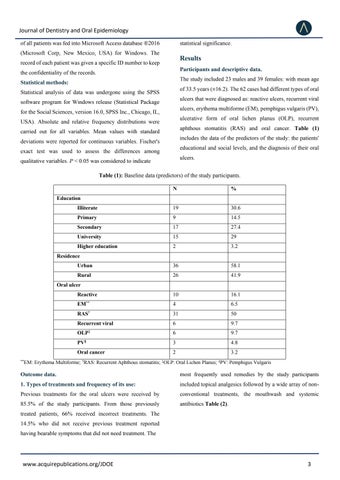Journal of Dentistry and Oral Epidemiology of all patients was fed into Microsoft Access database ®2016
statistical significance.
(Microsoft Corp, New Mexico, USA) for Windows. The
Results
record of each patient was given a specific ID number to keep
Participants and descriptive data.
the confidentiality of the records.
The study included 23 males and 39 females: with mean age
Statistical methods:
of 33.5 years (±16.2). The 62 cases had different types of oral
Statistical analysis of data was undergone using the SPSS
ulcers that were diagnosed as: reactive ulcers, recurrent viral
software program for Windows release (Statistical Package
ulcers, erythema multiforme (EM), pemphigus vulgaris (PV),
for the Social Sciences, version 16.0, SPSS Inc., Chicago, IL,
ulcerative form of oral lichen planus (OLP), recurrent
USA). Absolute and relative frequency distributions were
aphthous stomatitis (RAS) and oral cancer. Table (1)
carried out for all variables. Mean values with standard
includes the data of the predictors of the study: the patients'
deviations were reported for continuous variables. Fischer's
educational and social levels, and the diagnosis of their oral
exact test was used to assess the differences among
ulcers.
qualitative variables. P < 0.05 was considered to indicate
Table (1): Baseline data (predictors) of the study participants. N
%
Illiterate
19
30.6
Primary
9
14.5
Secondary
17
27.4
University
15
29
Higher education
2
3.2
Urban
36
58.1
Rural
26
41.9
10
16.1
4
6.5
31
50
6
9.7
OLP
6
9.7
PV§
3
4.8
Education
Residence
Oral ulcer Reactive EM
**
RAS
†
Recurrent viral ‡
Oral cancer **EM:
Erythema Multiforme;
†RAS:
Recurrent Aphthous stomatitis;
2 ‡OLP:
3.2 Oral Lichen Planus;
§PV:
Pemphigus Vulgaris
Outcome data.
most frequently used remedies by the study participants
1. Types of treatments and frequency of its use:
included topical analgesics followed by a wide array of non-
Previous treatments for the oral ulcers were received by
conventional treatments, the mouthwash and systemic
85.5% of the study participants. From those previously
antibiotics Table (2).
treated patients, 66% received incorrect treatments. The 14.5% who did not receive previous treatment reported having bearable symptoms that did not need treatment. The
www.acquirepublications.org/JDOE
3 3

